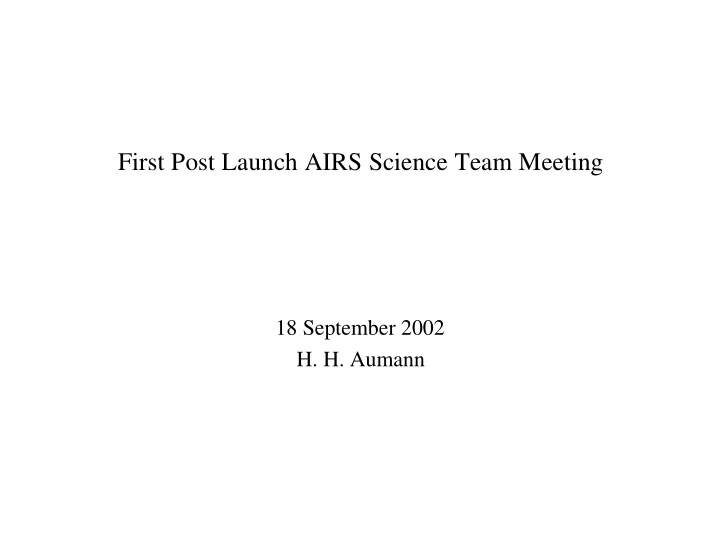

First Post Launch AIRS Science Team Meeting 18 September 2002 H. H. Aumann
We want AIRS data! We too want AIRS data!
My Topics: NRA and Science Team Restructure by July 2003 Deliverables at L+7 and L+12 months and Documentation TGRS Status, Conferences and Publications Data Decimation Early Analysis Status Future Meetings
Documentation The AIRS Data at the DAAC is much more valuable with proper documentation L+5 months: Post 20 July 2002 as sample data Parts of the netmeetings can be used, but not well focussed L+7 months Level 1b focus delivery of PGE by JPL Science Team contributes to the User Guide. Outline to be discussed later L+12 months Level 2 focus delivery of PGE by JPL Science Team contributes tasks they signed up for in the Validation Plan. Fetzer’s presentation ATBD Level 1b and Level 2 update at Launch + 18 months Open Literature Publications with these reports in mind can serve double duty.
TGRS Status , Conferences, Publications The AIRS/AMSU/HSB prelaunch papers set the stage for the documentation of the postlaunch performance. Most of the AIRS/AMSU/HSB papers are have passed the technical reviewer cycle and are now in the final editing phase. Jim Smith, TGRS Editor, wants to complete the final editing phase by 1 November 2002. The Aqua special issue will then be published early in 2003 (March?) In order to make the November 1, 2002 goal, the revised papers based on the reviewers comments need to be submitted to the final editing by October 1, 2002.
In order to maximize AIRS/AMSU/HSB data utilization the AIRS Science team is encouraged to give papers at Conferences: 23 September 02 Crete, Greece SPIE Europto: Aumann and Strow et al. (2 papers) 23 October 02 Hangzhou, China (Invited Paper): Pagano/Aumann December 2002 AGU meeting 9 February 2002 Quebec OSA (Goldberg organizer) (Special Session AIRS. Looking for 8 good papers) Could be combined with a team meeting 15 February 2003 Longbeach, AMS. Chahine paper, Tobin poster April 2003 Orlando SPIE June 2003 Anchorage: Chahine paper July 2003 Westcoast SPIE meeting (San Diego?) July 2003 Toulouse (IGARS) Could be combined with a team meeting October 2003 Peking (ITOVS) Nov 2003 Hawaii (Organized by Asrar) Could be combined with a team meeting
Data Decimation AIRS produces a large amount of data: 34 Gbytes/day level 1b 4 Gbytes/day cloud cleared level 1b 1 Gbyte/day retrievals Data volume OK for process studies using a few granules. If this data is spooled to tape, it is very slow to retrieve and make useful for global and climate studies, even with DAAC resource. Data needs to stay on RAID system. Data decimation: Not all data is needed by every body all places and all the time. Create several pre-decimated products at the DAAC. Pre-decimation: Need to figure out how to pre-decimate level 1b to about 1GByte/day or less as part of the routine DAAC data production 1GByte/day = 400GBytes/year = 3TByte/7 years = local copy is viable. Several ideas on this topic, also level 3 products. Science team needs to start thinking about specifics of data utilization Topic for next science team meeting.
Early IR Radiance (L1b) Evaluation using Earth Scene Data 12 February 2002 George Aumann 1. Radiometric Calibration 2. Scan Angle Effects 3. Spectral Calibration 4. Spatial Calibration 5. Noise Characterization 6. Other Ideas Outline for the L+7 months L1b focus delivery
JPL
Why does the AIRS team works on cloud detection? Identifying cloud-free footprints will be a topic directly or indirectly by all many of the speakers. Depending on the threshold less than 4%, perhaps less than 1% of AIRS footprints are cloud free. AIRS will use cloud clearing to allow utilization of up to 80% of the footprints. The AIRS team needs reliable clear FOV detection to 1) make sure that the radioemtric calibration and radiative transfer is done correctly, i.e. minimize tuning requirements. High yield is not an issue. Penalty is high for mixing un-identified clouds into the calibration or radiative transfer. Critical for climate research. 2) quality control cloud-cleared radiances (they must pass clear FOV test) The AIRS team requirement for cloud detection is not the same as for clear only retrievals or clear only assimilation. Both have a different tradeoff between cloud-contamination and yield.
Future AIRS Science Team Meetings 18 September 2002 Washington (Today) 15 October 2002 Net 15 November 2002 Net 15 December 2002 Net 7 January 2003 Pasadena (Level 1b focus reports) (February 2003 Quebec and Long Beach) 15 March 2003 Washington (Validation Reports) 15 April 15 Net May 2003 Pasadena Launch + 12 months. Final meeting of current AIRS team July 2003 Toulouse. Meeting of the NRA based AIRS Science team Nov 2003 Hawaii
Recommend
More recommend